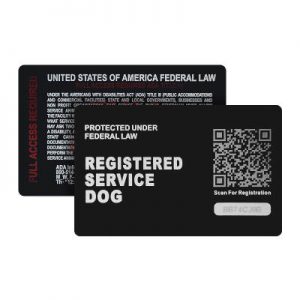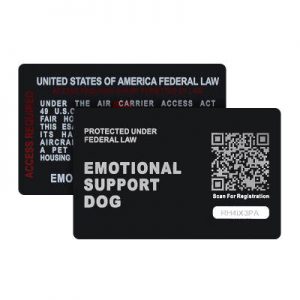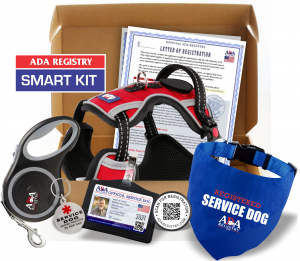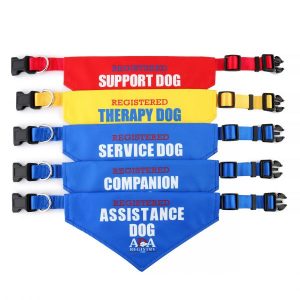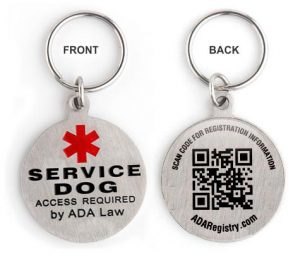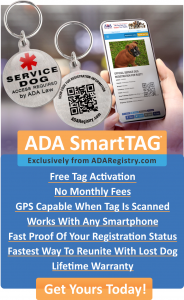Definition Of A Service Animal
How was the definition of “service animal” changed July 23, 2010?
How has the definition of “service animal” changed since 2009?
It has changed from:
-
- “Service animal means any guide dog, signal dog, or other animal individually trained to do work or perform tasks for the benefit of an individual with a disability, including, but not limited to, guiding individuals with impaired vision, alerting individuals with impaired hearing to intruders or sounds, providing minimal protection or rescue work, pulling a wheelchair, or fetching dropped items.”
Read Exact Text Here
It has changed to:
-
- “Service animal means any dog or other common domestic animal individually trained to do work or perform tasks for the benefit of an individual with a disability, including, but not limited to, guiding individuals who are blind or have low vision, alerting individuals who are deaf or hard of hearing to the presence of people or sounds, providing minimal protection or rescue work, pulling a wheelchair, fetching items, assisting an individual during a seizure, retrieving medicine or the telephone, providing physical support and assistance with balance and stability to individuals with mobility disabilities, and assisting individuals, including those with cognitive disabilities, with navigation. The term service animal includes individually trained animals that do work or perform tasks for the benefit of individuals with disabilities, including psychiatric, cognitive, and mental disabilities. The term service animal does not include wild animals (including nonhuman primates born in captivity), reptiles, rabbits, farm animals (including any breed of horse, miniature horse, pony, pig, or goat), ferrets, amphibians, and rodents. Animals whose sole function is to provide emotional support, comfort, therapy, companionship, therapeutic benefits, or to promote emotional well-being are not service animals.”
On July 23, 2010, Attorney General Eric Holder signed final regulations revising the Department’s ADA regulations, including a revised definition of “service animal.” This final rule was published in the Federal Register September 15, 2010, and the effective date is six months after that publication.
Effective March 15, 2011, “Service animal means any dog that is individually trained to do work or perform tasks for the benefit of an individual with a disability, including a physical, sensory, psychiatric, intellectual, or other mental disability. Other species of animals, whether wild or domestic, trained or untrained, are not service animals for the purposes of this definition. The work or tasks performed by a service animal must be directly related to the individual´s disability. Examples of work or tasks include, but are not limited to, assisting individuals who are blind or have low vision with navigation and other tasks, alerting individuals who are deaf or hard of hearing to the presence of people or sounds, providing non-violent protection or rescue work, pulling a wheelchair, assisting an individual during a seizure, alerting individuals to the presence of allergens, retrieving items such as medicine or the telephone, providing physical support and assistance with balance and stability to individuals with mobility disabilities, and helping persons with psychiatric and neurological disabilities by preventing or interrupting impulsive or destructive behaviors. The crime deterrent effects of an animal´s presence and the provision of emotional support, well-being, comfort, or companionship do not constitute work or tasks for the purposes of this definition.”
Key changes include the following:
1. Only dogs will be recognized as service animals.
2. Service animals are required to be leashed or harnessed except when performing work or tasks where such tethering would interfere with the dog’s ability to perform.
3. Service animals are exempt from breed bans as well as size and weight limitations.
4. Though not considered service animals, businesses are generally required to accommodate the use of miniature horses under specific conditions.
Until the effective date, existing service animals of all species will continue to be covered under the ADA regulations.
Existing policies that were clarified or formalized include the following:
1. Dogs whose sole function is “the provision of emotional support, well-being, comfort, or companionship” are not considered service dogs under the ADA.
2. The use of service dogs for psychiatric and neurological disabilities is explicitly protected under the ADA.
3. “The crime deterrent effects of an animal’s presence” do not qualify that animal as a service animal and “an animal individually trained to provide aggressive protection, such as an attack dog, is not appropriately considered a service animal.”
These previously existing policies are already in effect.


